Metal Detector Threshold Setting Explained

Written by Piotr Lesniewski
Detectorist • Scotland
As an Amazon Associate we earn commission from qualifying purchases. Read our full Affiliate Disclosure.
You’ve probably noticed that faint background hum on your metal detector and wondered if it’s normal or if something’s wrong. That subtle noise is your threshold setting at work—one of the most crucial yet misunderstood aspects of metal detecting.
When you set it correctly, you’ll find more targets and miss fewer treasures.
When it’s off, you might walk right over valuable finds without a single beep. Let’s uncover why this setting matters so much.
Key Takeaways
- Threshold is a continuous background hum confirming your detector is working properly while signaling subtle target responses.
- Set threshold by holding the coil steady, adjusting until you hear a faint hum that’s just audible without being distracting.
- A proper threshold setting helps detect small or deep targets that might only cause slight variations in background tone.
- Too high threshold causes ear fatigue and masks subtle signals; too low threshold means missing potential finds.
- Threshold settings work with sensitivity adjustments to optimize performance in varying soil conditions and environments.

What is Metal Detector Threshold?
The foundation of effective metal detecting lies in understanding the threshold setting. When you power on your detector, particularly in All-Metal or specialized prospecting modes, you’ll notice a continuous, faint background hum. This subtle tone is your threshold—the detector’s baseline audio signal that indicates it’s actively scanning the ground.
Unlike the distinctive beep that announces a shallow coin, the threshold serves as your detector’s voice, constantly communicating with you. As your search coil passes over metallic objects, this baseline sound will change—becoming louder, shifting in pitch, briefly dipping, or momentarily silencing.
These subtle audio variations alert you to potential targets that might otherwise go unnoticed. Properly setting and listening to your threshold transforms your detecting experience from random swinging to deliberate, methodical hunting.
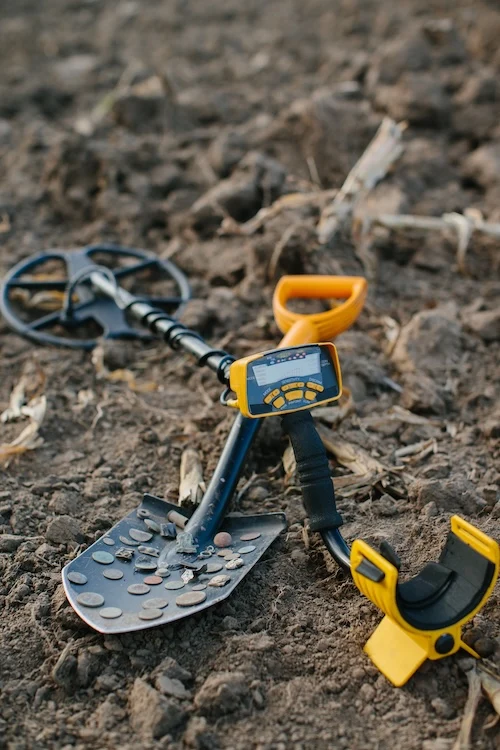
Why is Metal Detector Threshold Setting Important?
Setting your metal detector’s threshold correctly helps you find small or deeply buried items that might otherwise go undetected.
A properly adjusted threshold confirms your detector is working optimally while providing subtle feedback about ground conditions as you sweep.
You’ll also experience improved pinpointing accuracy in certain detecting scenarios, making target retrieval more efficient.
Detecting Small or Deep Targets
When hunting for small or deep targets, your detector’s threshold setting becomes absolutely crucial.
Those tiny gold nuggets, thin hammered coins, or deeply buried objects produce significantly weaker signals that often can’t generate a clear, distinct beep.
Instead of waiting for obvious audio alerts, you’ll need to train your ear to detect subtle variations in the threshold hum. These minor changes in the background sound are your only clue that something valuable lies beneath the surface.
While a weak target mightn’t break through complete silence, it can still create a noticeable shift in an already established threshold tone.
Confirmation of Operation
A properly set threshold serves as your detector’s heartbeat, providing immediate feedback that your equipment is working correctly.
That constant background hum isn’t just noise—it’s a continuous status indicator letting you know your detector remains fully operational as you search.
If this sound suddenly disappears when it shouldn’t, it immediately alerts you to potential issues like a dying battery or a disconnected search coil. This real-time operational feedback allows you to troubleshoot problems quickly.
Ground Condition Feedback (Subtle)
Beyond serving as an operational indicator, your properly adjusted threshold provides subtle intelligence about the ground beneath your search coil.
When you encounter areas with extreme mineralization changes or pass over “hot rocks,” you’ll notice your threshold becoming unstable. These subtle audio variations aren’t random noise; they’re valuable signals indicating your ground balance needs attention.
Enhanced Pinpointing (in some scenarios)
A properly maintained threshold tone significantly enhances your pinpointing accuracy in All-Metal mode.
When you’ve set a stable threshold, pay close attention to where exactly the sound peaks as you pass over a target. This audio cue serves as a precision tool that can reveal the target’s exact location before you start digging.
By moving your coil slowly and listening for the specific point where the threshold reaches its maximum intensity, you’ll reduce unnecessary digging and recover items more efficiently.
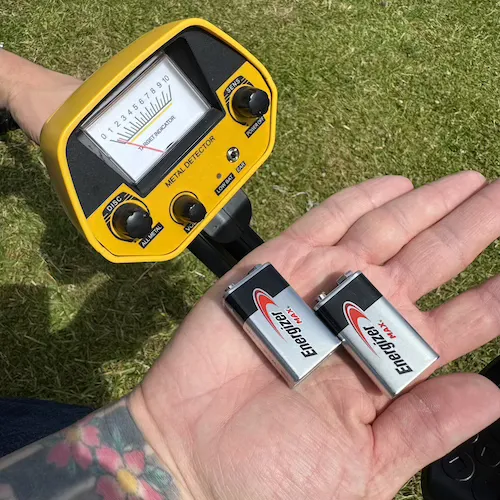
How Does Metal Detector Threshold Work?
When you adjust your metal detector’s threshold, you’re essentially fine-tuning its ears to hear the faintest whispers from beneath the ground. This adjustment establishes the detector’s baseline sensitivity level—a constant, barely audible hum that serves as your reference point.
As you search, metallic objects disrupt the electromagnetic field your detector creates. These disruptions, even minimal ones, cause subtle modulations in the threshold sound that your trained ear can perceive.
The ideal threshold setting is just audible enough—a soft, consistent background hum that’s comfortable to listen to for extended periods.
With proper threshold adjustment, you’ll catch those faint signals from small or deep targets that might otherwise go unnoticed.
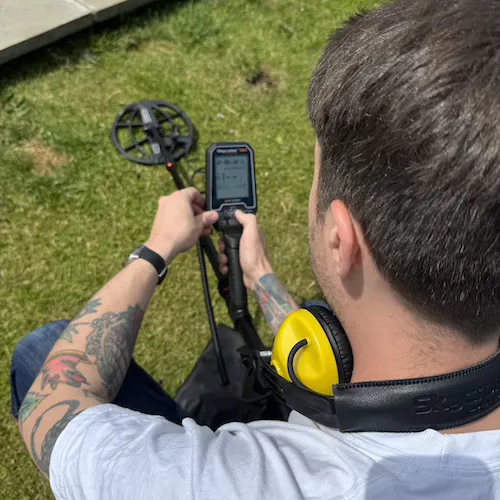
When To Use Threshold Setting?
You’ll want to use threshold settings primarily when operating your metal detector in All-Metal Mode or specialized Prospecting Modes where subtle target signals matter.
Threshold adjustment also proves valuable in certain Relic Hunting Modes where distinguishing faint signals from deeper artifacts becomes essential.
Keep in mind that not every metal detector offers adjustable threshold capabilities, so check your specific model’s features.
All-Metal Mode
The heart of metal detecting lies in the All-Metal mode, where proper threshold adjustment becomes essential for maximum performance. Unlike discriminative modes that filter out certain metals, All-Metal mode aims to detect every metallic object beneath your coil.
When you’re operating in All-Metal, you’ll want to find that sweet spot where your machine hums quietly but remains responsive to the smallest targets. Your threshold setting in this mode directly impacts how deeply and accurately you’ll detect buried treasures.
Prospecting Modes
Prospecting for gold demands a different approach. When hunting for gold, you’ll want to run your threshold slightly higher than normal, creating a more sensitive detection field.
By maintaining an audible threshold, you’ll catch those subtle variations when your coil passes over even the smallest gold pieces.
Remember to adjust your threshold to a level that’s comfortable for extended periods. You’ll be listening intently for hours, so find that sweet spot where it’s loud enough to detect small nuggets but not so intrusive that it causes listening fatigue.
Some Relic Hunting Modes
When hunting for relics, you’ll want maximum depth capabilities to uncover deeply buried items that have settled over decades or centuries.
Setting an audible threshold helps you detect the faintest signals from deeply buried metallic objects, including iron relics that might have historical significance. With a properly set threshold, you’ll hear subtle changes in the audio tone when your coil passes over these deeply buried iron objects.
Not all metal detectors have an adjustable threshold.
While understanding threshold concepts is valuable, it’s important to recognize that not all metal detectors offer adjustable threshold settings. Many entry-level and mid-range machines come with fixed thresholds.
Before attempting to adjust your threshold, consult your detector’s manual. Understanding your specific model’s capabilities will prevent frustration and help you maximize its performance within its design limitations.
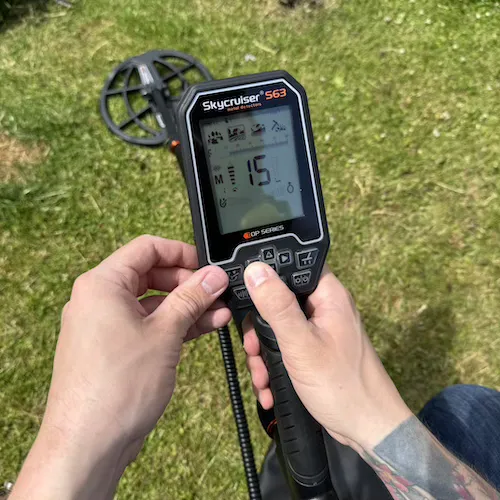
How to Set the Threshold
Setting the perfect threshold on your metal detector involves a few straightforward steps:
Ensure your detector is in the appropriate mode (e.g., All-Metal).
Hold the search coil still, away from any known metal targets and at your normal search height.
Locate the threshold adjustment control.
If your detector is silent: Slowly increase the threshold level until you hear a faint, steady hum emerge.
If the threshold is too loud or erratic: Slowly decrease the level until the sound becomes a very faint, smooth, and stable hum.
The ideal setting is the quietest possible sound that you can consistently hear. It should not be distracting or fatiguing.
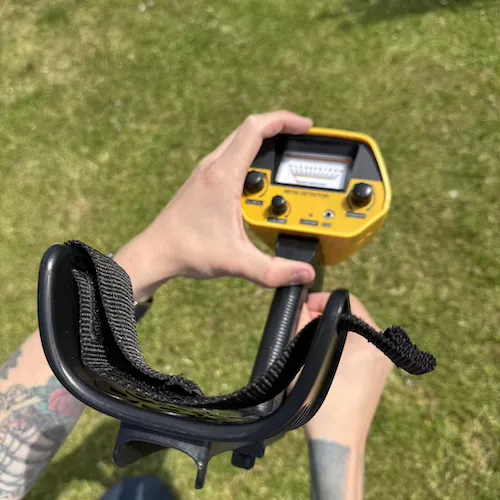
What if it’s Too High?
When your threshold is set too high, you’ll struggle to discern the subtle audio changes that small or deeply buried targets produce.
Think of it like trying to hear someone whisper in a noisy room—the important details get lost in the overwhelming sound.
The louder baseline makes minor signals nearly impossible to distinguish, causing you to miss potentially valuable finds. Additionally, listening to a loud threshold for extended periods is mentally exhausting.
What if it’s Too Low (or Silent)?
When your threshold is set too low or completely silent, you’re essentially handicapping your metal detector.
Without this baseline sound, you’ll miss the subtle audio changes that indicate weak targets. These faint signals cause only slight variations in the threshold hum—variations you won’t hear if there’s no hum to begin with.
Think of it like turning the volume too low on your car radio when listening for traffic reports. If it’s too quiet, you’ll miss the important announcements.

Adjusting Metal Detectors Threshold Setting for Conditions
You should modify your threshold settings when encountering changes in ground mineralization or noisy environments. Remember to frequently readjust your threshold throughout your detecting session as conditions change.
Noisy Environments
Detecting in noisy environments presents unique challenges. When you’re facing strong winds (particularly common in Scottish detecting locations) or traffic noise, you might struggle to hear a faint threshold.
The better approach is investing in quality headphones. Good headphones effectively block external noise, allowing you to maintain your threshold at the optimal faint level where detectors perform best.
This simple equipment choice eliminates the need to compromise your settings, ensuring you don’t miss those important signals.
Ground Mineralization Changes
Your threshold stability serves as the most reliable indicator of changing ground conditions.
If you suddenly hear your threshold become erratic, louder, or significantly quieter when moving to a new area, you’re encountering a change in ground mineralization. This instability is your detector’s way of telling you it’s no longer properly balanced.
Don’t ignore these threshold fluctuations. Take a moment to re-ground balance your detector whenever you notice these changes.
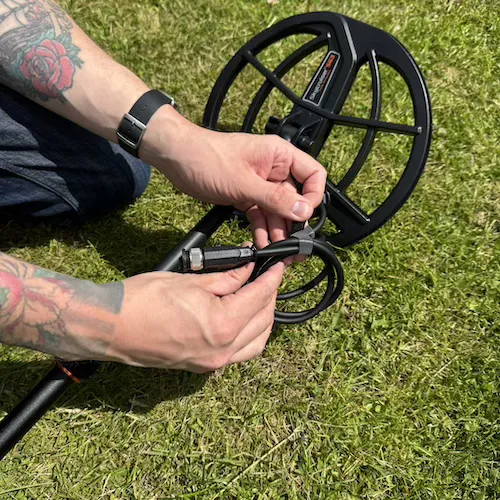
Relationship with Other Metal Detector Settings
Your threshold interacts with several key settings that impact overall performance, including All-Metal Mode, Sensitivity, Volume, and Discrimination.
All-Metal Mode
When operating in All-Metal mode, the threshold setting becomes particularly critical as it directly influences your detector’s overall performance. This mode relies on your ability to interpret threshold fluctuations, making proper setting crucial for successful hunting.
Sensitivity (Gain)
The interplay between sensitivity and threshold settings determines the ultimate effectiveness of your metal detector.
Without a stable threshold, high sensitivity settings become problematic rather than beneficial.
High sensitivity not only boosts target signals but also amplifies ground noise. If you’ve set your sensitivity too high, the resulting “chatter” will make your threshold unstable. For optimal performance, adjust both settings in tandem.
Volume
To optimize your settings, first set your threshold to a barely audible level. This establishes your baseline sensitivity.
Once that’s properly calibrated, use the main volume control to bring both sounds to comfortable listening levels, especially when using headphones. This two-step approach prevents the common mistake of setting threshold and volume improperly in relation to each other.
Discrimination Modes
In discrimination modes, your detector produces distinct beeps only for accepted targets while rejected targets remain silent.
When operating in discrimination mode, you’ll notice the concept of threshold becomes less critical than it is in All-Metal mode, as your attention shifts from monitoring subtle variations in background noise to identifying clear, distinct audio signals.
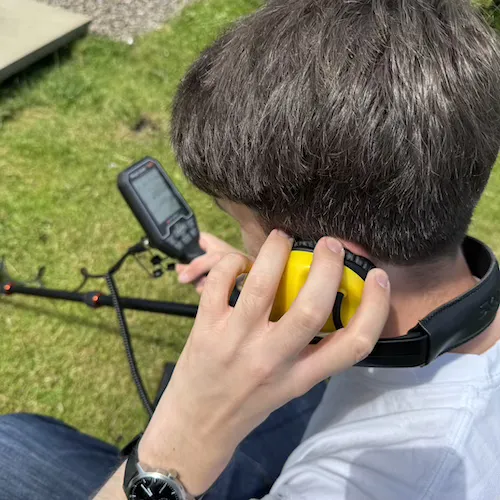
Key Tips for Using Metal Detector Threshold
Mastering your threshold setting requires specific tips and techniques to maximize your success.
HEADPHONES ARE ESSENTIAL
When you’re hunting for treasure in Scotland’s windy conditions, headphones become your most crucial accessory for proper threshold operation. The subtle audio cues simply can’t be detected reliably without them.
Don’t compromise on this equipment – investing in proper headphones isn’t optional if you’re serious about maximizing your finds.
Train Your Ear
Successful metal detecting relies heavily on your ability to interpret the threshold’s subtle language of audio cues.
Pay attention to slight rises, falls, wavers, or complete nulling of the background hum. Start in your yard with known targets at various depths, listening carefully to how each affects the threshold.
With time, you’ll develop an almost instinctive reaction to threshold changes that many beginners miss completely.
Check Your Manual
Your detector’s manual holds the specific knowledge needed for your model’s threshold settings. Not all detectors adjust threshold in the same way, and manufacturer-specific instructions are crucial for optimal performance.
Don’t skip this research step – understanding the technical specifics of your detector’s threshold mechanism will dramatically improve your finds.
Smooth and Steady Wins the Race
A properly set threshold delivers a smooth, consistent audio backdrop. If your threshold sounds jumpy or erratic, something’s wrong. This typically indicates one of three issues: your sensitivity setting is too high, your ground balance needs adjustment, or you’re experiencing electromagnetic interference (EMI).
Remember that stability matters more than volume. A faint, steady threshold will serve you better than a louder, inconsistent one.
Listen for the “Absence” of Sound Too
Experienced detectorists also pay close attention to moments when the threshold suddenly goes quiet.
This phenomenon, known as “nulling out,” occurs when certain objects or ground conditions cause your detector’s audio to briefly dip rather than rise. These brief absences of sound can be just as significant as the more obvious beeps and tones.
Conclusion
You’ll get the most from your metal detecting when you’ve mastered threshold settings. It’s not just background noise—it’s your detector’s voice telling you what’s happening underground. Set it properly, adjust for conditions, and you’ll catch signals you’d otherwise miss. Remember, a faint hum means you’re ready to find treasure that silent detectors would pass right over.
Author Profile

Piotr Lesniewski
"Digging up the past, one signal at a time."
Polish-born, Scotland-based, and obsessed with the beep. My passion began decades ago, exploring fields with my Dziadek (grandfather). Now, with over 10 years of digging under my belt, I'm here to share everything I've learned—unfiltered and unbiased—to help you unearth your own piece of history. No sales pitches, just real field experience.